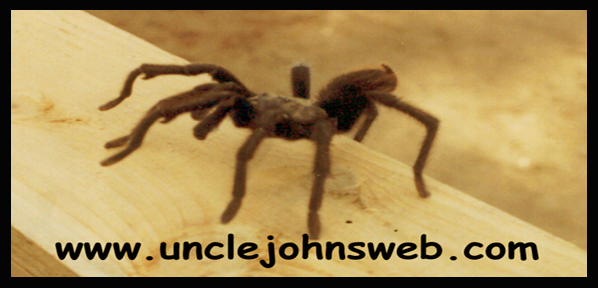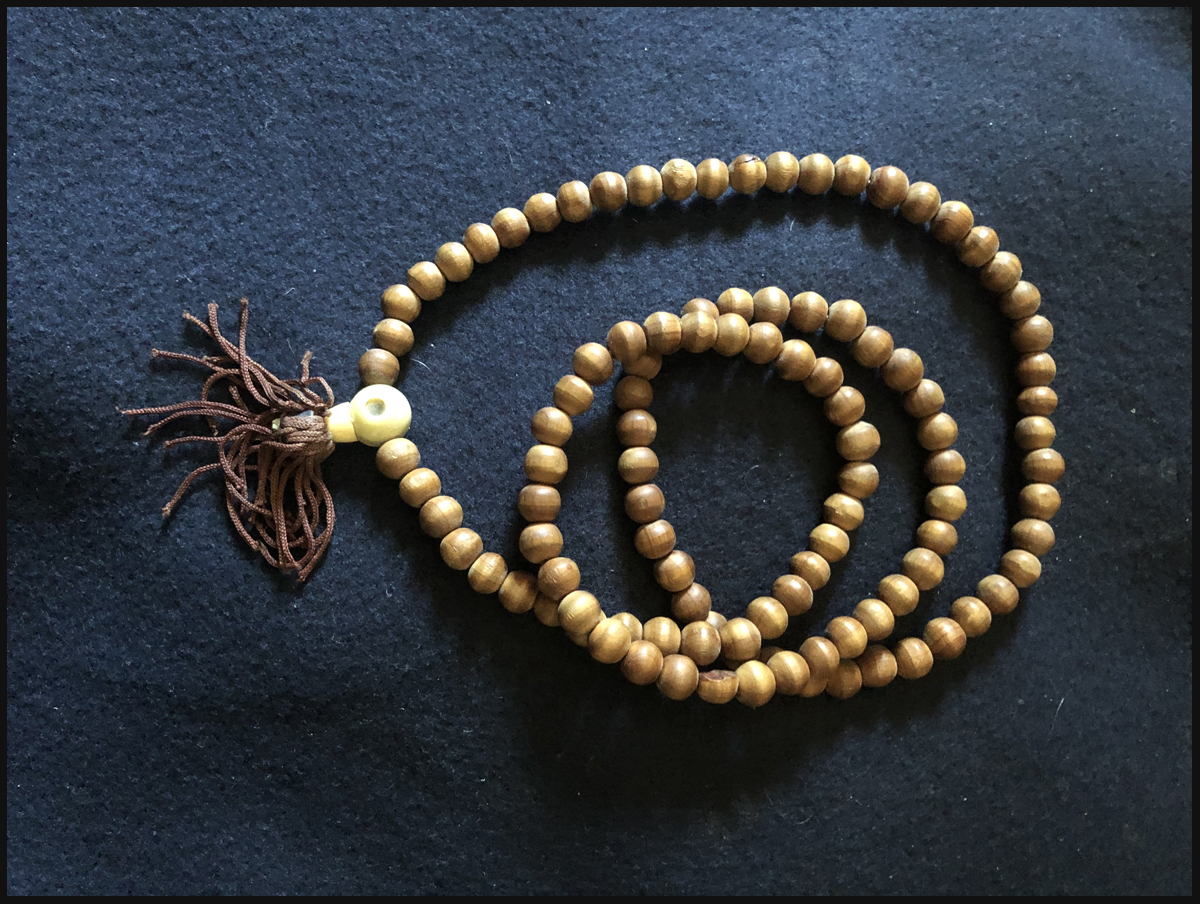
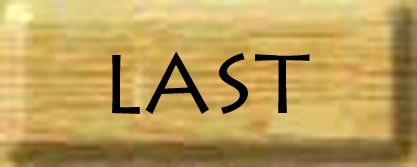

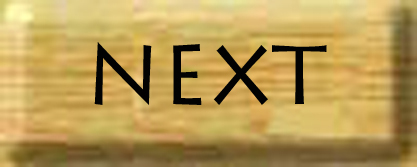
Ojuzu Beads
OK. The Buddha beads, Ojuzu, draped over a wooden statue of a wandering Bodhisattva carrying incense. The statue I could have parted with. It was a garage sale find, and had little significance to me other than it made me think of the person who gave me the beads. Now that the carving and the beads have become forever linked, they will have to stay together.
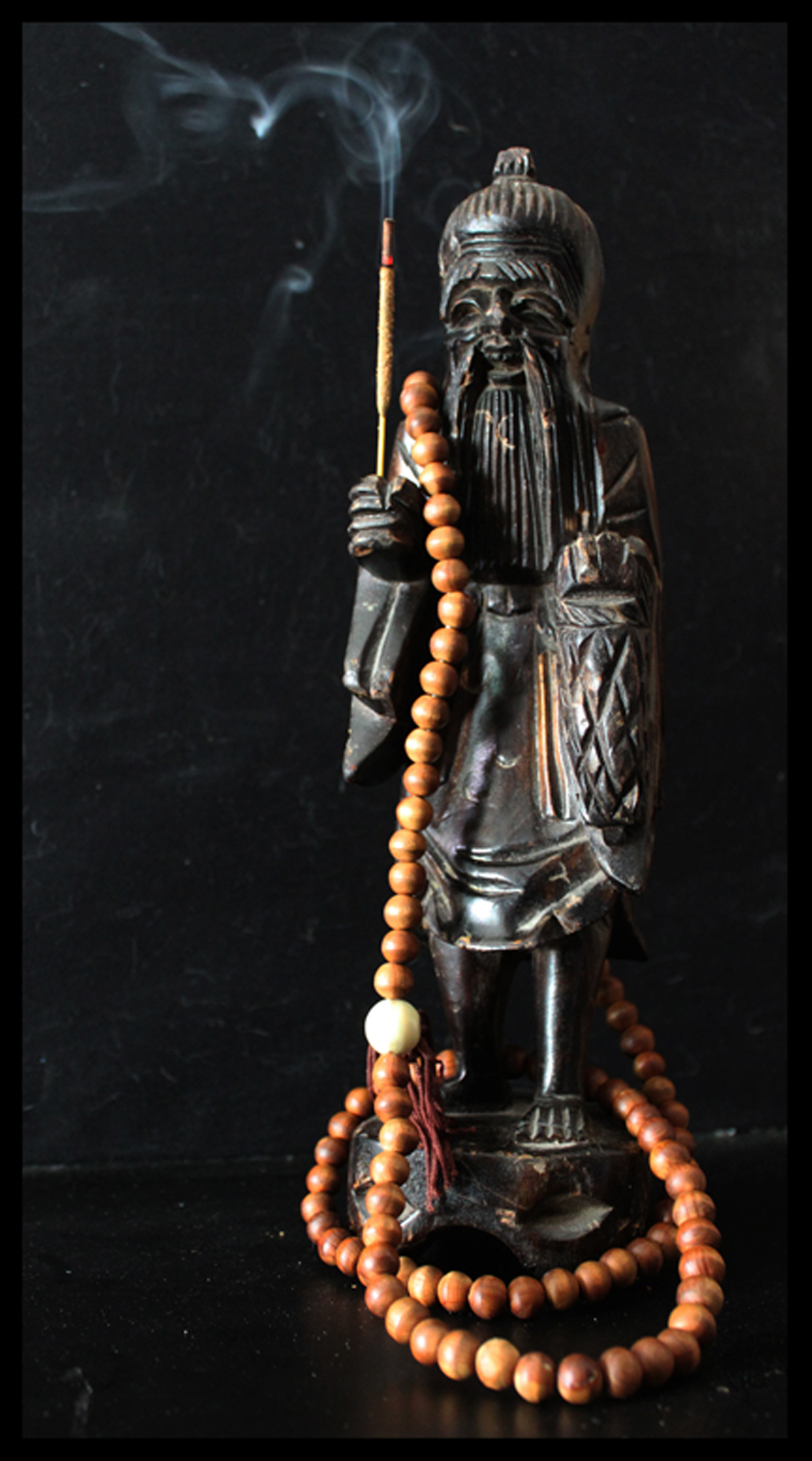
In 1983, I was living near Pahoa on the Big Island of Hawaii, a single father living with my 12 year old son, JW, and our three dogs off the grid on the edge of an ohia forest. I worked building small houses in the area. I had an old Ford truck and one day when I was about 100 feet from my driveway, it started acting like it had slipped out of gear; engine still running but no power to the back wheels. I stopped and looked back to see that the right rear wheel had moved out about three feet from where it belonged. The keepers that kept the axle in its housing had failed and let it slip out. We jacked it up and slid the wheel back into position, then pushed the truck on into the driveway.
The next two weeks I spent trying to fix it. The problem being, one of the problems being, that we lived off the grid, hence no phone. It was 3 miles to the main road, then 12 miles to Hilo the nearest source of parts. So I would partly walk and partly hitchhike to town, go to the Ford dealer look through their parts catalog, try to figure out what I needed buy it, hitchhike and walk home, find out whether it fit, go back. After a few trips like that we determined that my truck had been put together with parts from several model years. I finally figured out what year model the axle housing was, hitchhiked walked one last time and back and got the truck rolling again.
The very first drive I took, I drove the three miles down to the main road, turned left toward Keaau. In about a half mile, on the side road by Maku'u Drive there was a tall man with a shaved head wearing some kind of a robe, and by the way he was standing let it be known he was looking for a ride. I pulled over and let him in and I said, "I'm repaying a karmic debt." He seemed interested in my use of the phrase. I went on to explain what I meant, that for the past two weeks I had been relying on the generosity of random strangers giving me rides to Hilo and back, and anywhere else I wanted to go. Now I was repaying not them personally, but the whole general pool of human goodwill.
He introduced himself as Nichijo, and asked if I knew who he was. I didn't. He said he was a Buddhist priest, a bishop in fact. In the 8 miles to Keaau, he outlined some of the facts of his life and they sounded quite preposterous, unbelievable, because if they were true, I was riding along here with a genuine historical figure. Didn't seem likely. But what he told me was easily checked.
I was stopping in Keaau to see my friends there, and dropped him near Gaughen's Emporium. I went into to see Tim and Nichijo went to the roadside to continue to Hilo. A half hour later, after I had seen my buddies and was ready to travel onto Hilo myself, he was still waiting. So I picked him up again and took him to Hilo, more stories.
His stories were about his WW II experiences; his capture at the island fortress of Corregidor in the mouth of Manila Bay, three and a half year in Japanese prison camps, being forced to make POW propaganda broadcasts from Radio Tokyo, years of post-war harassment, and being charged with treason and put on trial for his life. I had to check this out.
The Hilo Public Library is a pleasure: a comfortable place to do research, to look stuff up and read some California newspapers; and I was surprised to find they had a complete microfiche file of the New York Times. That meant that I should be able to find evidence of what Nichijo had told me. Sure enough, in the index under his original name I found 93 New York Times articles that solely concerned Nichijo and his trial in the early 1950's.
Over the next month, I kept running into Nichijo, and I was usually giving him a ride somewhere and several times took him to his hermitage up the hill behind Pahoa. The path from the road to his place went through the grey-green ohia trees with a forest floor carpeted with impatiens and lilies. The building itself was about as simple and basic as a dwelling could possibly be. Somewhere along the line it was agreed that I would undertake to write his biography.
Now, how am I going to make this long story short?
To back up here, I attended the University of California at Santa Barbara for most of the years between 1961 and 1969. When asked what I was studying to be, my answer was "a civilian"; and as my generation came of age just in time for the Vietnam War, I was in no hurry to finish up. Stretching it out for as long as I could, I treated myself to a leisurely liberal arts education of the kind that had no goal of career or practical purpose, but to explore what interested me. By the end of 1968 my girlfriend and future wife, Patti, had graduated and was moving to the San Francisco Bay area. I had to wrap it up there at UCSB to join her. The credits I had accumulated in my explorations amounted to nearly enough for two bachelor's degrees, so my last year was spent finishing off the requirements. In August 1969, I graduated with a BA in Political Science, and a BA in Religious Studies. My religious studies mainly concerned Buddhism.
When I finally did decide what my life's work would be, it was to find adventures in building, houses mainly, which I is what I had been doing. Now unexpectedly, I found myself uniquely qualified, and in position to do some writing along the lines of my college education. I started doing the serious preparation and research in the summer of 1984. I would write up a few chapters, have him over to review them and answer what questions had occurred to me since the time before, and by the end of 1985 we were sending completed manuscripts out to publishers. We got a lot of rejection letters, of course, but we did get one nibble and some very good advice from a big time publisher, Morgan Entrekin, and I had started to work on the rewrite along the suggested lines.
Then one day Nichijo told me we had to postpone publication of the book. He had gotten cold feet. Years before, when he was living in Honolulu, a newspaper story about him raised all the issues that had plagued him since 1941, and it was emotionally very, very hard to revisit the accusations.
He had realized that it would happen again with the publication of the book. We sent the latest version off to the Copyright Office, and I packed all my research notes and rough drafts into a small trunk where it sat for most of next 30 years. I needed to get back to making a living. Every once in a while, I would open up that little black cube, make a little progress, then close it up again. JW and I moved off to the mainland in 1986, and I didn't see Nichijo again.
I learned of his death in 2001, when I was about to leave for China with Johnny. I didn't get around to paying my respects at is gravesite in Hilo until 2004.
The way the copyright law works, upon the death of my co-author, all the say-so to publish, or not, or to rewrite, became mine. Still, I was enjoying making my living in my chosen way, and it took me another 10 years to get back at it again. In late spring 2014, I took advantage of a short break in my work schedule to spend a few weeks at the plugging away at the rewrite until I burned out, then I put it away again for who knows how long.
Then in September, I got a Facebook message inquiring if I was the John Oliver that co-authored a book with Nichijo Shaka. "Why, yes I am," I wrote her back. She said that she was a serious researcher who was gathering info about Nichijo for her own book, and she wanted to interview me by telephone. I told her that I wanted to share my book with her first, but I needed a couple of weeks. I pulled out the Nichijo trunk again, and this time I wrapped it up. In two weeks time, I was sending the rewritten manuscript off to the Copyright Office, and a copy to her, and put it up for sale by the end of October.
Anyway, the longer version of his story available in print from online bookstores and in every kind of e-reader format: Nichijo: The Testimony of John Provoo, but this story is about the beads.
August 6, 1984. I picked up Nichijo at his dojo up behind Pahoa, to take him to Hilo on the occasion of his 67th birthday. He was going to a celebration in his honor at a local restaurant. We stopped at the Pahoa Cash and Carry to get him a half pint of brandy. By the time we reached Keaau, 10 miles away, he required another half pint, and we stopped at the Akiyama store. Then, before we had gone another 30 yards, he had me stop again, across the street from the Hongwanji.
"It's my birthday, I must honor my parents!"
Hongwanji is the most common form of Buddhism practiced by Japanese residents of Hawaii. It was laid out like a typical Christian church anywhere in America. There was a center aisle through rows of pews leading to an altar, a pulpit off to the left side, and the right side of the sanctuary was a choir box. Except for the substitution of the Buddha Amithaba for Jesus; a Baptist or a Methodist would feel right at home.
We went up the front steps and I reached the door before him and began to open it, then I closed it. "Nichijo. There's already some kind of service going on."
He reached into the pocket of his robe and pulled out this very string of ojuzu beads. He said something in Japanese as he placed them around my neck. "Okay now, we are Buddhist priests and we can go in."
We walked in, went up the aisle and sat in the front row. We waited respectfully for a few moments, then Nichijo got up and approached the altar. He lit two sticks of incense and made a ceremonial invocation for his mother and father in Japanese. Then we left, went on our way to Hilo.
I have never tried to pass myself off as a Buddhist priest, but I do treasure these beads and the story of how I got them.
When I completed the book and was setting up the print version, I had an idea for the cover. I simply took the statue and the beads that are usually draped over it, leaving it where it usually stands in my bedroom, against a black background, and snapped a photograph of it with a short piece of incense in its hand and the smoke swirling around.
The book has a life of is own, and now that the Bodhisattva and the ojuzu beads have been immortalized as a pair, they must stay together.
How can I put a price on them? Save for estate sale.

Not for sale. Uncle John's Garage Sale is the name of the book.



© 2022 John Oliver
All Rights Reserved
mail@unclejohnsweb.com
